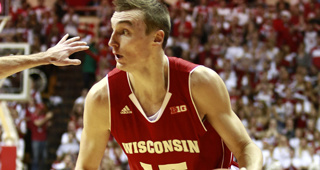Our position-by-position look at the top NBA prospects coming back to school next season continues with the small forward position, a position which has become increasingly difficult in recent years. With floor spacing the name of the game in the NBA, it’s very hard to hide a small forward who can’t shoot 3’s. The problem is there just aren’t many 6’7+ players with the length and athleticism to match up with NBA small forwards who also have the skill-set to drain 25+ foot shots. A small forward who can’t shoot 3’s has to have the game to be a primary offensive option at the next level, since the ball will naturally wind up in their hands. As a result, it’s become a bit of an all-or-nothing position - there’s no such thing as a role playing SF who can’t stretch the floor at the next level. Going into next season, there aren’t many players coming back to the college game who can play the SF position in the NBA, but there are even fewer who can shoot 3’s. If there’s a role model for these guys, it’s Kawhi Leonard, who went from a 29% three-point shooter at San Diego State to 38% with the San Antonio Spurs. You just don’t see a player make that transition too often. For every Leonard or Lance Stephenson who become better shooters, there are a dozen D-League wing players who are a three-point shot from making millions of dollars in the NBA. If there is another Chip Engelland out there, he could be a very rich man. Rondae Hollis-Jefferson, Arizona - RHJ started to come on strong towards the end of last season, moving into the starting line-up when Brandon Ashley went down with a foot injury. Arizona had some floor spacing issues playing him with Aaron Gordon together, so he should have a much bigger role as a sophomore, with Gordon off to the NBA. From a physical standpoint, RHJ is as talented a player as any in the country - a 6’7 215 ball of fast twitch muscles with a long wingspan. The most intriguing thing about his game is his passing ability, which he didn’t always get to showcase as a freshman, when he was more of a secondary option. However, he’s an excellent ball-handler with a great feel for the game, who had 6 assists against UNLV and 5 against Gonzaga in the NCAA Tournament. If he can develop a three-point shot over the summer, he could be a Top 5 pick. Even without one, RHJ could have a long career as an Andre Iguodala type player. Sam Dekker, Wisconsin - Dekker, like most of Bo Ryan’s players at Wisconsin, passed up a chance to be a first-round pick to come back to school as an upperclassmen. As a junior, he will be expected to team with Frank Kaminsky and lead the Badgers to a Big Ten title. NBA scouts have little patience for older players who stay in school and plateau - to remain in the first-round pick conversation, Dekker will need to have a Big Ten POY caliber season next year. At 6’7 220, he is a solid all-around player with surprising athleticism, who averaged 12 points and 6 rebounds a game on 47% shooting as a sophomore. While he doesn’t have ideal size for an NBA SF, he should have a long career at the next level as a versatile player who can swing between both wing positions. After playing off the ball in his first two seasons, Dekker should be given the opportunity to create more shots for himself and others as a junior. Alex Poythress, Kentucky - At 6’8 240, Poythress projects as more of a PF, but there won’t be many minutes for him at the position at Kentucky, where he will have to fight for playing time with Karl Towns, Trey Lyles and Marcus Lee. Poythress has the athleticism and shooting stroke to play on the perimeter, but he has the tendency to float and not impact the game when he’s playing too far from the basket. He’s still only a junior, which makes him an old man in Lexington. Branden Dawsen, Michigan State - At 6’6 225, Dawsen is a freak athlete who plays much bigger than his size. If the NBA doesn’t work out for him, he might want to think about the NFL. The question for him is simple - he doesn’t have the size to play in the post in the NBA, like he does in college as an undersized 4, and he doesn’t have the skill-set to score on the perimeter. If Dawsen could shoot 3’s, he would be a first-round pick. Without a jumper, though, it will be difficult. LeBryan Nash, Oklahoma State - After being seen as a possible one-and-done player coming out of high school, Nash has turned in a solid college career at OSU. With Marcus Smart and Markel Brown gone, Nash will have to carry a huge offensive load as a senior. At 6’7 215, he has an elite first step that makes him a very difficult cover as a stretch 4 in college. However, to play in the NBA, Nash will need to develop a three-point shot in his final season in Stillwater. Other names to watch: Troy Williams (Indiana)

Jonathan Tjarks wrote on the NBA for RealGM from 2011-2016 before joining The Ringer.
Follow @JonathanTjarks on Twitter.


